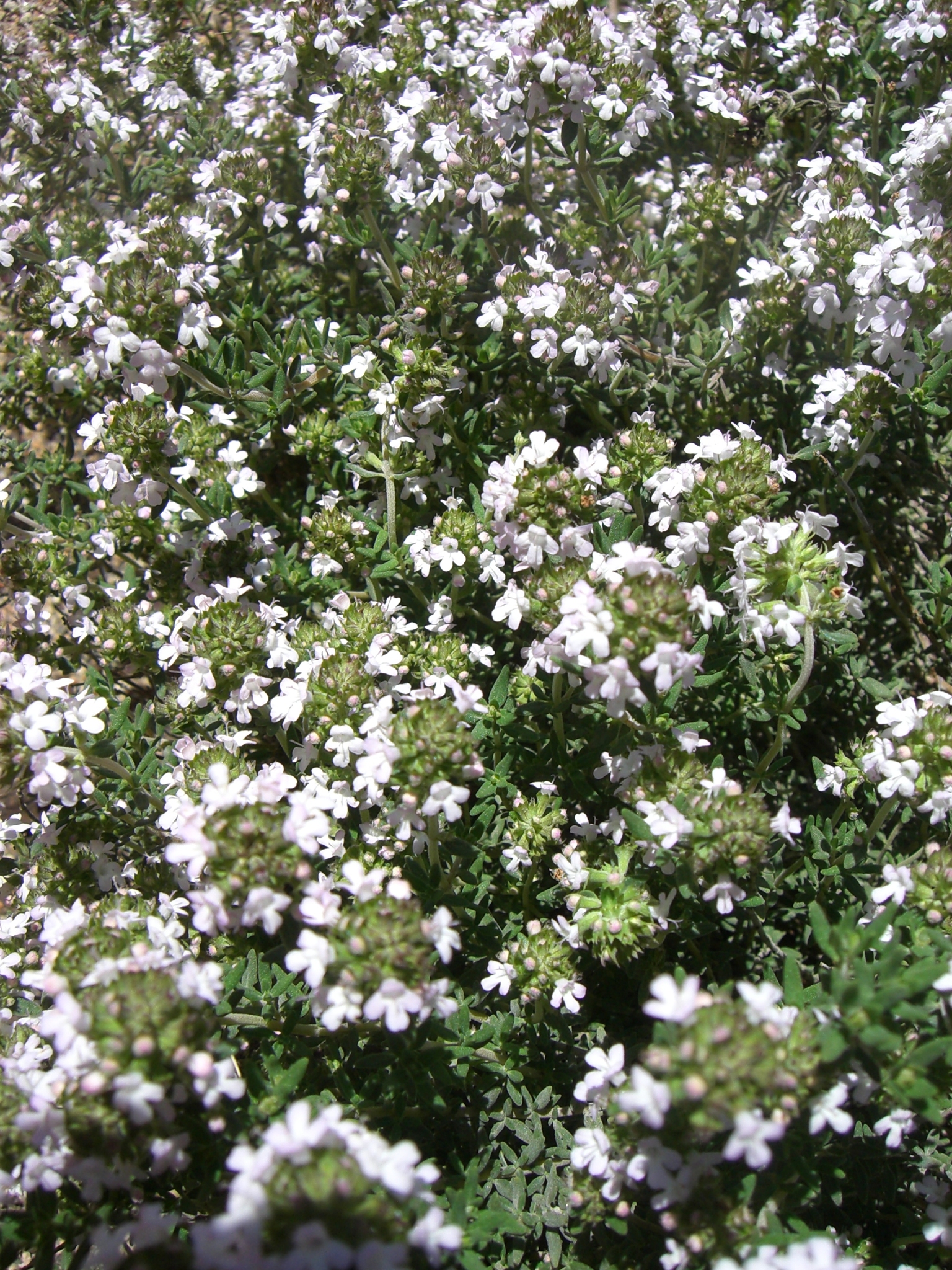
Greek Thymos — the name used by Theophrastus and Dioscorides. Etymology uncertain.
Low-growing, small-leaved, evergreen shrubs. Stems to 30 cm, erect, ascending, or prostrate and matforming, usually hairy. Leaves small, usually less than 1 cm long, linear to elliptic, gland-dotted, often hairy. Flowers in verticillasters, forming a dense head, an interrupted 'spike', or axillary. Bracts similar to the leaves or broader. Calyx straight, usually 10-nerved, hairy inside, 2-lipped, the lower lip usually with 2 long, narrow, often ciliate teeth, the upper lip usually with 3 smaller, triangular teeth. Flower tube bell-shaped, 2-lipped, the upper lip entire or notched, the lower lip shortly 3-lobed, white to purple. Stamens 4, 2 usually parallel under the upper lip of the corolla, 2 diverging and conspicuous; poorly developed and enclosed within the corolla tube in female flowers. Style protruding, 2-lobed. Fruit of 4 small nutlets.
Thymes have long been cultivated for their fragrant and antiseptic oils.The prostrate species are useful as groundcovers in raised beds and in rock gardens or between pavers. Occasionally grown are two erect species in which the bracts are very different from the leaves: T. capitellatus, with green bracts; and the similar T. camphoratus, with purple bracts. Coridothymus (Thymus) capitatus, with leaves triangular in cross-section and a calyx tube with 20-22 veins,may also occur. Numerous other species and cultivars are now available in cultivation in Britain and the USA
The classification of thymes has long been a problem. Some species show great variation and hybrids are also common. Several features of thymes have added to the confusion:
Descriptions are based on well-watered plants growing in sandy soil and flowering for the first time since being raised from cuttings, divisions or seed.
Division, cuttings or seed. Hybridisation is common between some species. Most thymes on sale are propagated vegetatively and most seem to be female.
Cultivated as culinary herbs and for their fragrant and antiseptic oils (T. vulgaris, T. mastichina, T. zygis, T. pulegioides).
Low-growing, small-leaved, fragrant subshrubs with wiry stems, woody at least at the base; flowers in terminal heads or interrupted spikes; bracts usually like the leaves or broader; calyx clearly 2-lipped; corolla white, pink or purple, with very little variation in hue.
50-400 species distributed in Europe and Asia but extending to Greenland and N Africa, on heathlands, grasslands, alpine and arctic meadows, rocky slopes and cliffs. The greatest diversity is seen in the limestone mountains of S Europe and W Asia.
Pigott (1953), Jalas (1971), Stearn (1974), Flannery (1982), White & White (1994), Phillips & Rix (1998), Thompson (1998). Most popular books have some mislabelled illustrations.
Two keys are presented here: a key to the species based on material growing in Australia and a key to variegated and golden thymes. The the majority of variegated and golden thymes are difficult to assign to a species and the short key maybe helpful. For a description refer to the species in brackets. The colours are best in winter and spring. Most readily revert to the green form.
Source: (2002). Thymus. In: . Horticultural Flora of South-eastern Australia. Volume 4. Flowering plants. Dicotyledons. Part 3. The identification of garden and cultivated plants. University of New South Wales Press.

Small shrub with diverging to erect branches, soon rooting at the nodes. Stems hairy all round. Leaves green, suffused with yellow to a varying degree. Yellow colour more prominent on regrowth from old prostrate branches. Flowers sparse, axillary, pale lilac. [T. 'Anderson's Gold' a cultivar name coined to replace the everyday name T. 'Bertram Anderson']
This cultivar is usually assigned to T. ×citriodorus.
A hybrid with T. mastichina as the female parent. Pollen probably from T. polytrichus.
Habit like a small T. mastichina. Leaves lanceolate, petiolate, margins occasionally toothed, ciliate and with longer hairs on the undersurface. Lateral veins indistinct. Upper lip of calyx with teeth 3 times as long as wide. Cilia about 0.7 mm long. Corolla very pale pink and without markings.
Apparently identical to T. 'Bertram Anderson'.
Discovered in the Blue Mountains Botanic Garden Mount Tomah, Sydney;
Open, mat-forming shrub with decumbent rather than creeping stems; stems hairy all round. Leaves grey-green, broadly spoon-shaped to rhomboid, with long and short hairs on the margins and both surfaces. Flowering heads about 15 mm wide, developing on decumbent shoots; heads elongating to produce interrupted 'spikes'. Flowers female, teeth of upper lip of calyx ciliate, lower lip of corolla faintly tinged pink. Flowering period long.
This hybrid of unknown parentage has been sold as T. 'Pink Chintz', a cultivar which appears not to be grown in Australia. [T. 'Pink Chintz']